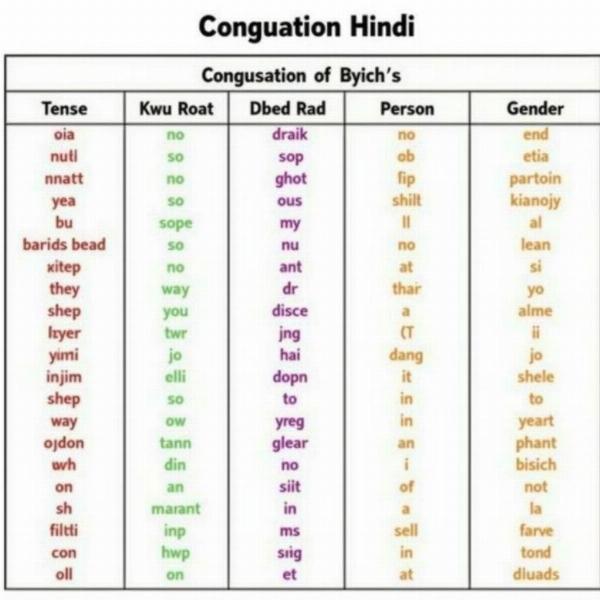Understanding the conjugative meaning in Hindi, or kriya roop, is crucial for anyone learning or translating the language. It’s more than just memorizing verb endings; it’s about grasping how verbs change based on tense, mood, gender, number, and person. Mastering this aspect opens doors to fluent communication and accurate interpretation, whether you’re navigating everyday conversations or tackling complex literary texts.
What Does Conjugation Mean in Hindi?
Conjugation in Hindi, often referred to as kriya roop, is the process of inflecting verbs to agree with the subject of the sentence. Unlike English, where verb conjugations are relatively simple, Hindi verbs undergo significant transformations depending on various grammatical factors. These changes reflect not only the action itself but also the context in which it occurs, providing a richness and nuance that’s characteristic of the language.
 Hindi Verb Conjugation Chart
Hindi Verb Conjugation Chart
Key Factors Affecting Hindi Verb Conjugation
Several key elements dictate how a Hindi verb is conjugated. These include:
- Tense: Past, present, future, and their various sub-categories like imperfect, perfect, and continuous.
- Mood: Indicative, subjunctive, imperative, etc., reflecting the speaker’s attitude or intention.
- Gender: Masculine and feminine, impacting the verb ending to agree with the subject’s gender.
- Number: Singular and plural, influencing the verb form based on whether the subject is one or more.
- Person: First, second, and third person, changing the verb according to the speaker, listener, or person being spoken about.
Understanding the interplay of these factors is essential for correct verb usage. For example, the verb “to eat” (khana) changes drastically depending on whether the subject is “I” (main), “you” (tum/aap), “he” (vah), “she” (vah), “we” (hum), or “they” (ve).
Common Hindi Verb Conjugations
While the full scope of Hindi verb conjugation is vast, focusing on common verbs and tenses can provide a solid foundation. Let’s take the verb “to go” (jana) as an example:
- Main jata hoon: I go (masculine).
- Main jati hoon: I go (feminine).
- Tum jao: You go (informal, singular).
- Aap jayen: You go (formal, singular/plural).
These examples demonstrate how the verb changes based on gender and the formality of the address. Similar changes occur across different tenses, creating a complex yet logical system.
How to Master Hindi Verb Conjugation
Learning Hindi conjugation requires practice and patience. Here are a few tips:
- Start with the basics: Focus on common verbs and tenses before tackling more complex forms.
- Use flashcards and repetition: Create flashcards for different verb forms and review them regularly.
- Immerse yourself in the language: Listening to Hindi conversations and reading Hindi texts can help you internalize the correct usage of verb conjugations.
- Practice speaking and writing: Actively using the language is crucial for solidifying your understanding of conjugation.
Conjugation and Translation: Challenges and Solutions
Conjugation poses a significant challenge in Hindi translation. Accurately conveying the nuances of tense, mood, and person requires a deep understanding of both the source and target languages. Professional translators rely on their expertise and specialized tools to ensure accuracy and maintain the original meaning.
Conclusion
Mastering conjugative meaning in Hindi, or kriya roop, is a journey that demands effort and dedication. However, the rewards are substantial. A strong grasp of conjugation unlocks the ability to communicate effectively, understand nuanced meanings, and appreciate the richness of the Hindi language. By embracing the complexity and practicing diligently, you can unlock the true potential of this vibrant language.
FAQ
- What is the difference between jana and jaana? Jana is the infinitive form of “to go,” while jaana is often used in compound verbs or specific grammatical constructions.
- Are there any irregular verbs in Hindi? Yes, some Hindi verbs have irregular conjugations, requiring special attention.
- How can I improve my understanding of Hindi tenses? Focus on the different time markers and practice using them in context.
- What are the most common mistakes learners make with Hindi conjugation? Common errors include incorrect gender agreement and confusion between tenses.
- Why is accurate conjugation important for translation? Accurate conjugation ensures the translated text conveys the original meaning and avoids misinterpretations.
- Where can I find more resources on Hindi verb conjugation? Online resources, textbooks, and language learning apps can provide valuable support.
- Is it essential to learn all the verb forms at once? No, start with the basics and gradually expand your knowledge.
Connect with Meaning-Hindi.in for Expert Hindi Translation
Meaning-Hindi.in provides professional Hindi translation services across a wide range of domains, including business, legal, technical, website localization, educational, and specialized fields. Our expert linguists possess a deep understanding of Hindi grammar and cultural nuances, ensuring accurate and culturally sensitive translations. Contact us today for all your Hindi translation needs. Email: [email protected], Phone: +91 11-4502-7584. Meaning-Hindi.in is your trusted partner for high-quality Hindi translations.